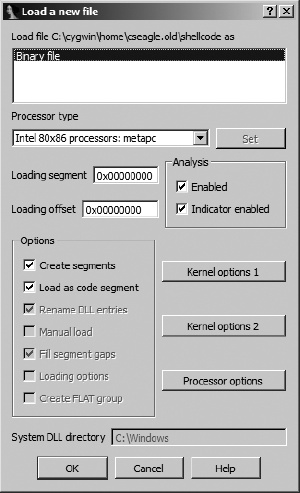One day word will get out that you have become the resident IDA geek. You may relish the fact that you have hit the big time, or you may bemoan the fact that from that day forward, people will be interrupting you with questions about what some file does. Eventually, either as a result of one such question or simply because you enjoy using IDA to open virtually every file you can find, you may be confronted with the dialog shown in Figure 18-1.
This is IDA’s standard file-loading dialog with a minor problem (from the user’s perspective). The short list of recognized file types contains only one entry, Binary file, indicating that none of IDA’s installed loader modules recognize the format of the file you want to load. Hopefully you will at least know what machine language you are dealing with (you do at least know where the file came from, right?) and can make an intelligent choice for the processor type, because that is about all you can do in such cases.
In this chapter we will discuss IDA’s capabilities for helping you make sense of unrecognized file types, beginning with manual analysis of binary file formats and then using that as motivation for the development of your own IDA loader modules.
An infinite number of file formats exist for storing executable code. IDA ships with loader modules to recognize many of the more common file formats, but there is no way that IDA can accommodate the ever-increasing number of formats in existence. Binary images may contain executable files formatted for use with specific operating systems, ROM images extracted from embedded systems, firmware images extracted from flash updates, or simply raw blocks of machine language, perhaps extracted from network packet captures. The format of these images may be dictated by the operating system (executable files), the target processor and system architecture (ROM images), or nothing at all (exploit shellcode embedded in application layer data).
Assuming that a processor module is available to disassemble the code contained in the unknown binary, it will be your job to properly arrange the file image within an IDA database before informing IDA which portions of the binary represent code and which portions of the binary represent data. For most processor types, the result of loading a file using the binary format is simply a list of the contents of the file piled into a single segment beginning at address zero, as shown in Example 18-1.
Example 18-1. Initial lines of a PE file loaded in binary mode
seg000:00000000 db 4Dh ; M seg000:00000001 db 5Ah ; Z seg000:00000002 db 90h ; É seg000:00000003 db 0 seg000:00000004 db 3 seg000:00000005 db 0 seg000:00000006 db 0 seg000:00000007 db 0
In some cases, depending on the sophistication of the selected processor module, some disassembly may take place. This may be the case when a selected processor is an embedded microcontroller that can make specific assumptions about the memory layout of ROM images. For those interested in such applications, Andy Whittaker has created an excellent walk-through[128] of reverse engineering a binary image for a Siemens C166 microcontroller application.
When faced with binary files, you will almost certainly need to arm yourself with as many resources related to the file as you can get your hands on. Such resources might include CPU references, operating system references, system design documentation, and any memory layout information obtained through debugging or hardware-assisted (such as via logic analyzers) analysis.
In the following section, for the sake of example we assume that IDA does not recognize the Windows PE file format. PE is a well-known file format that many readers may be familiar with. More important, documents detailing the structure of PE files are widely available, which makes dissecting an arbitrary PE file a relatively simple task.


